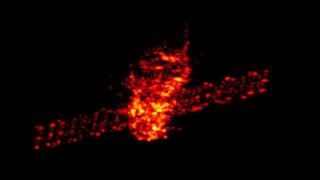INSUBCONTINENT EXCLUSIVE:
Image copyrightFRAUNHOFERImage caption
China's space lab Tiangong-1 was tracked on radar
China's
defunct Tiangong-1 space lab mostly broke up on re-entering the Earth's atmosphere above the South Pacific, Chinese and US reports say.It
re-entered the atmosphere around 00:15 GMT on Monday, China's Manned Space Engineering Office said.Tiangong-1 was launched in 2011 to
carry out docking and orbit experiments.It was part of China's efforts to build a manned space station by 2022, but stopped working in
What do we know about where it came downThe rather vague "above the South Pacific" is the line from space officials
US specialists at the Joint Force Space Component Command said they had used orbit analysis technology to confirm Tiangong-1's re-entry
Astronomer Jonathan McDowell, from the Harvard-Smithsonian Center for Astrophysics, tweeted that it appeared to have come down north-west of
Experts had struggled to predict exactly where the lab would make its re-entry - and China's space agency wrongly suggested it would be
off Sao Paulo, Brazil, shortly before the moment came.The European Space Agency said in advance that Tiangong-1 would probably break up over
water, which covers much of the Earth's surface.It stressed that the chances of anyone being hit by debris from the module were "10
million times smaller than the yearly chance of being hit by lightning".It's not clear how much of the debris reached the Earth's
surface intact.Why did the space lab fall like thisIdeally, the 10m (32ft)-long Tiangong module would have been taken out of orbit in a
planned manner.Traditionally, thrusters are fired on large vehicles to drive them towards a remote zone over the Southern Ocean
This option appears not to have been available after the loss of command links
Thirteen space agencies, under the leadership of the European Space Agency, used radar and optical observations to follow Tiangong's path
around the globe.Tiangong means 'Heavenly Palace'Image copyrightGetty ImagesImage caption
Astronaut Wang Yaping
memorably gave a lecture to school children from Tiangong-1
The module was launched in 2011 to practise rendezvous and
dockingTwo astronaut crews visited in Shenzhou capsules - in 2012 and 2013They included China's first female astronauts Liu Yang and Wang
YapingChina plans a more permanent space station in the next decadeIt has developed a heavy-lift rocket, Long March 5, for the purpose Is
this the biggest space hardware to fall out of the skyTiangong was certainly on the large size for uncontrolled re-entry objects, but it was
far from being the biggest, historically: The US space agency's Skylab was almost 80 tonnes in mass when it came back partially
Parts struck Western Australia but no-one on the ground was injured Nasa's Columbia shuttle would also have to be classed as an
Its mass was more than 100 tonnes when it made its tragic return from orbit in 2003
Again, no-one on the ground was hit as debris scattered through the US states of Texas and Louisiana Astrophysicist Jonathan McDowell
believes Tiangong is only the 50th most massive object to come back uncontrolled
China has launched a second lab, Tiangong-2, which continues to be operational
It was visited by a re-fuelling freighter, Tianzhou-1, just last year
China's future permanent space station is expected to comprise a large core module and two smaller ancillary modules, and will be in
service early in the next decade, the Asian nation says
A new rocket, the Long March 5, was recently introduced to perform the heavy lifting that will be required to get the core module in orbit.

